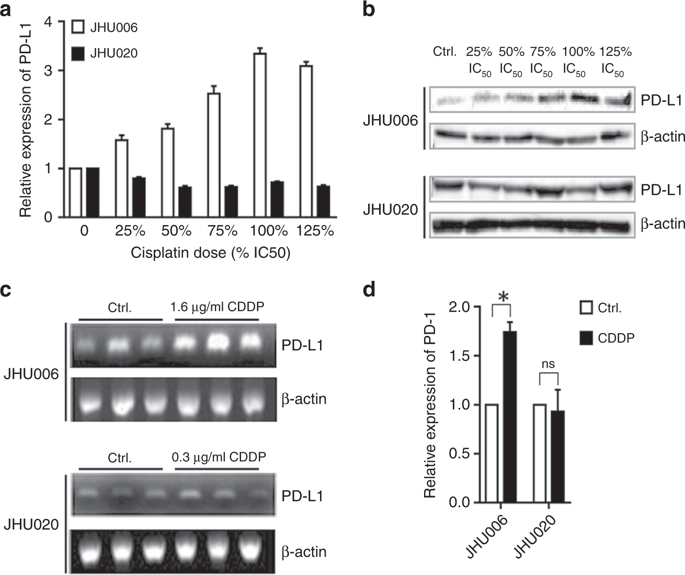当前位置:
X-MOL 学术
›
Br. J. Cancer
›
论文详情
Our official English website, www.x-mol.net, welcomes your
feedback! (Note: you will need to create a separate account there.)
PD-L1 and MRN synergy in platinum-based chemoresistance of head and neck squamous cell carcinoma.
British Journal of Cancer ( IF 6.4 ) Pub Date : 2019-12-19 , DOI: 10.1038/s41416-019-0697-x Bin Shen 1, 2 , Dongyan Huang 1, 3 , Andrew J Ramsey 1 , Kevin Ig-Izevbekhai 1 , Kevin Zhang 1 , Shayanne A Lajud 1, 4 , Bert W O'Malley 1 , Daqing Li 1
British Journal of Cancer ( IF 6.4 ) Pub Date : 2019-12-19 , DOI: 10.1038/s41416-019-0697-x Bin Shen 1, 2 , Dongyan Huang 1, 3 , Andrew J Ramsey 1 , Kevin Ig-Izevbekhai 1 , Kevin Zhang 1 , Shayanne A Lajud 1, 4 , Bert W O'Malley 1 , Daqing Li 1
Affiliation

|
BACKGROUND
We have been investigating the molecular mechanisms of cisplatin-induced chemoresistance in head and neck squamous cell carcinoma (HNSCC). Based on our previous findings, the present study investigates how the Mre11, Rad50, and NBS1 (MRN) DNA repair complex interacts at the molecular level with the programmed cell death ligand 1 (PD-L1) in cisplatin-induced chemoresistance.
METHODS
Human HNSCC cell lines were used to determine the role played by PD-L1 in cisplatin resistance. Initial experiments investigated PD-L1 expression levels in cells exposed to cisplatin and whether PD-L1 interacts directly with the MRN complex. Finally, in vitro studies and in vivo experiments on BALB/c nu/nu mice were performed to determine whether interference of PD-L1 or NBS1 synthesis modulated cisplatin resistance.
RESULTS
Exposure to cisplatin resulted in PD-L1 being upregulated in the chemoresistant but not the chemosensitive cell line. Subsequent co-immunoprecipitation studies demonstrated that PD-L1 associates with NBS1. In addition, we found that the knockdown of either PD-L1 or NBS1 re-sensitised the chemoresistant cell line to cisplatin. Finally, but perhaps most importantly, synergy was observed when both PD-L1 and NBS1 were knocked down making the formerly chemoresistant strain highly cisplatin sensitive.
CONCLUSIONS
PD-L1 plays a pivotal role in cisplatin resistance in chemoresistant human HNSCC cell lines.
中文翻译:

PD-L1 和 MRN 在头颈鳞状细胞癌铂类化疗耐药中的协同作用。
背景我们一直在研究顺铂诱导头颈鳞状细胞癌(HNSCC)化疗耐药的分子机制。基于我们之前的发现,本研究探讨了 Mre11、Rad50 和 NBS1 (MRN) DNA 修复复合物如何在分子水平上与程序性细胞死亡配体 1 (PD-L1) 相互作用,从而产生顺铂诱导的化疗耐药性。方法 使用人类 HNSCC 细胞系来确定 PD-L1 在顺铂耐药中所起的作用。最初的实验研究了暴露于顺铂的细胞中的 PD-L1 表达水平以及 PD-L1 是否直接与 MRN 复合物相互作用。最后,对 BALB/c nu/nu 小鼠进行体外研究和体内实验,以确定干扰 PD-L1 或 NBS1 合成是否会调节顺铂耐药。结果 暴露于顺铂会导致化疗耐药细胞系中的 PD-L1 上调,但化疗敏感细胞系中的 PD-L1 不会上调。随后的免疫共沉淀研究表明 PD-L1 与 NBS1 相关。此外,我们发现 PD-L1 或 NBS1 的敲低使化疗耐药细胞系对顺铂重新敏感。最后,但也许最重要的是,当 PD-L1 和 NBS1 都被敲除时,观察到协同作用,使得以前的化疗耐药菌株对顺铂高度敏感。结论 PD-L1 在化疗耐药的人 HNSCC 细胞系的顺铂耐药性中发挥着关键作用。
更新日期:2019-12-19
中文翻译:

PD-L1 和 MRN 在头颈鳞状细胞癌铂类化疗耐药中的协同作用。
背景我们一直在研究顺铂诱导头颈鳞状细胞癌(HNSCC)化疗耐药的分子机制。基于我们之前的发现,本研究探讨了 Mre11、Rad50 和 NBS1 (MRN) DNA 修复复合物如何在分子水平上与程序性细胞死亡配体 1 (PD-L1) 相互作用,从而产生顺铂诱导的化疗耐药性。方法 使用人类 HNSCC 细胞系来确定 PD-L1 在顺铂耐药中所起的作用。最初的实验研究了暴露于顺铂的细胞中的 PD-L1 表达水平以及 PD-L1 是否直接与 MRN 复合物相互作用。最后,对 BALB/c nu/nu 小鼠进行体外研究和体内实验,以确定干扰 PD-L1 或 NBS1 合成是否会调节顺铂耐药。结果 暴露于顺铂会导致化疗耐药细胞系中的 PD-L1 上调,但化疗敏感细胞系中的 PD-L1 不会上调。随后的免疫共沉淀研究表明 PD-L1 与 NBS1 相关。此外,我们发现 PD-L1 或 NBS1 的敲低使化疗耐药细胞系对顺铂重新敏感。最后,但也许最重要的是,当 PD-L1 和 NBS1 都被敲除时,观察到协同作用,使得以前的化疗耐药菌株对顺铂高度敏感。结论 PD-L1 在化疗耐药的人 HNSCC 细胞系的顺铂耐药性中发挥着关键作用。











































 京公网安备 11010802027423号
京公网安备 11010802027423号